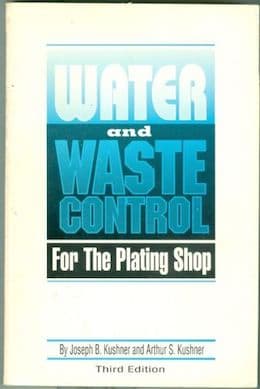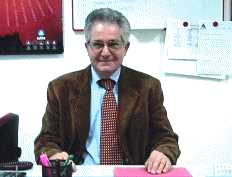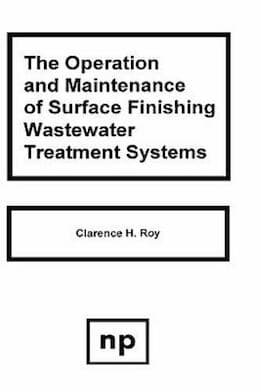
-----
Reducing COD in Waste Water
⇦ Tip: Readers want to learn from your situation;
so some readers skip abstract questions.
Q. We use the common method of chemical precipitation to treat electroplating wastewater. Despite good chemical treatment, BOC is still high. How to purify BOD and COD?
Abbas Farazmand- tehran Iran
December 20, 2023
A. Hi Abbas.
I assume there is a typo there, and you are asking how to reduce BOD?
If you have high BOD despite an acceptable COD, peroxide additions or ozone treatment should do it.
The usual way of dealing with BOD is biological treatment, but that is probably not economically & logistically appropriate for a waste treatment plant for electroplating wastewater.
Read on for what others have done re. high COD.
Luck & Regards,

Ted Mooney, P.E. RET
Striving to live Aloha
finishing.com - Pine Beach, New Jersey
Ted is available for instant help
or longer-term assistance.
⇩ Related postings, oldest first ⇩
by Kushner & Kushner

on eBay (rarely)
or Amazon (rarely)
(affil link)
Q. How can I reduce COD (chemical oxygen demand) in the waste water?

Sara Michaeli
Tel-Aviv-Yafo, Israel
2001
A. Sara,
I may be up a gum tree, as we say, but to increase the oxygen content of your waste water, have you ever tried to arrange a system such that nature will help?
In the fishery business a way they use is to discharge oxygen depleted water at a reasonably high level, 6 feet to 12 feet or so.
The discharge empties into a round plastic pipe or tube. There are a number of these identical tubes and each one is at least 9" above the next one. They are about 18" in diameter but could be larger.
Each tube has a perforated plate at the base to prevent 'packing', i.e. plastic mass transfer packing, from falling out ... although the Fisheries, being a little bit cheap, did use some fairly poorly designed packing.
The modus operandi is that this oxygen starved water falls down into and onto the packing where the flow is distributed and then dribbles out, reasonably evenly, from the perforated plate. Due to the 'fall' of the water, it automatically sucks in some ambient air = oxygen.
Ergo, ipso facto, you now have some somewhat oxygenated H20. OK? Let's hope it will work for you. If it does, please remit $ 10,000,000.00 so that I can afford to go on vacation! Good luck !

Freeman Newton [deceased]
(It is our sad duty to advise that Freeman passed away
April 21, 2012. R.I.P. old friend).
A. Sara,
I found on the web this site:
www.h2o2.com/industrial/applications.aspx?pid=104&name=BOD-COD-Removal ⇩
Maybe it can help you.
Good luck

Francesco Cicchetti
- Sulmona, Italy
[Ed. update: The above link is broken -- don't go there. Thankfully, Internet Archive preserved a copy here
These days information often never sees print, then disappears forever. If you find that concerning, please consider a donation to The Internet Archive.
A. Sara, Before I start looking for process technologies to solve various waste and pollution issues; I always like to take the process creating the waste back to ground zero and look at it from the point of view of what can be done to eliminate or change the various materials, process steps, equipment, etc. that is causing the waste or pollution in the first place and yet still maintain product specification. Or if that is not possible, change the product spec. such that, process changes can be made. I.E., "Change the process and material and spec., eliminate the waste". In order to do this effectively, this requires a little work and creativity.
If this is ineffectual or impossible, then end of pipe treatment technology is required. As for solving a high COD problem, this can be normally masked by oxygenating the waste stream by contacting the waste process stream with air or by the injection of oxygen. But remember, this is adding on additional equipment, materials, energy, etc. (hence increased maintenance and operations costs) There are plenty of vendors world wide that can supply this process technology. Check any of the waste water or chemical process websites.
Neil E. Hatfield- Franklin Park, Illinois, USA
A. Sara,
Removing or reducing chemical oxygen demand can be done with a variety of ways including utilizing some chemical pretreatment, biological remediation or bio-augmentation in activated batch reactors wastewater pretreatment units. Depending on the upstream source that is contributing the high loads of COD in question and the daily volume loads needing treatment you may discover that you might be able to adjust the upstream contributing problems areas process control and reduce any problem areas. Small daily volume loadings ( less than 500 gallons ) may be cost effectively evaporated at $0.03-$0.10 per gallon. Pretreatment of high COD loadings is a bit of a challenge in the real world. Be cautious of any "Blue-Sky" remedies. COD loadings and the difficulties in treating them will vary as they are impacted by pH, various chloride loadings, temperature, presence of heavy metals, surfactants, F-M food to microbial loadings ratios, etc.
Fill in more info on your process, COD loadings, COD characteristics, goals, etc., to help paint a better picture of what you are facing.
Brian Lamphron- Sioux Falls, South Dakota, USA
2007
A. Sara,
You can reduce the COD using various methods. The best method I suggest to you if the COD of your effluent is more than 20000 mg/L.Then you should go for AOP (advanced oxidation processes). First bring the effluent pH to around 5-6 and treat with Fentons Reagent, wait for the flocs to settle.Then filter the supernatant using Activated Carbon filter. You will be surprised to see much reduction of COD after filtration.
- Chennai,tamilnadu, India
Q. Dear Sir;
Can you help more in using Fenton's Reagent in wastewater treatment. I will appreciate your support.
Best Regards
- Turkey
August 29, 2010
Hi Hashim. Please see
www.h2o2.com/industrial/fentons-reagent.aspx?pid=84&name=Fenton-s-Reagent ⇩
and/or Wikipedia .
Regards,

Ted Mooney, P.E.
Striving to live Aloha
finishing.com - Pine Beach, New Jersey
Ted is available for instant help
or longer-term assistance.
[Ed. update: The above link is broken -- don't go there. Thankfully, Internet Archive preserved a copy here
These days information often never sees print, then disappears forever. If you find that concerning, please consider a donation to The Internet Archive.
Q. At SBR inlet, COD and BOD-3 values are 750 and 250 mg/l. Is it possible to achieve COD is <125 and BOD <15 after SBR treatment? Or do we need to provide sand filter and activated carbon filter after SBR? Effluent from Seepage Water Pump discharge, CRW and Effluent from Boiler Area under pressure to Equalization tanks and Oily water Sewer effluent (water seal drum of flare, floor wash, backwash effluent from ACF and diesel storage washing are main effluent for primary treatment.
Arindam MukherjeeOil and Gas - Vadodara, India
March 20, 2012
Q. Give me better solution for reducing COD in ETP [effluent treatment plant] or aeration.
Prajapati Damodarstudent, no company - Ahmedabad, India
December 15, 2012
by Clarence Roy

on eBay or Amazon
or AbeBooks
(affil link)
A. Hi cousin Prajapati. Five answers were offered above.
If you can express your question in terms of someone's previously posted response, people may be able to help you :-)
Or maybe your need is for a tutorial textbook on the subject? ⇨
Best of luck!
Regards,

Ted Mooney, P.E.
Striving to live Aloha
finishing.com - Pine Beach, New Jersey
Ted is available for instant help
or longer-term assistance.
December 2012
Q. Dear Sir/M'am,
My initial COD is 40000 mg/L but I want to reduce my COD up to 100 mg/L. What is feasible procedure?
- Vadodara
December 25, 2012
A. Hi Meeta. It may be possible to chemically precipitate most of the contaminant to remove it, or to chemically oxidize it, or to biologically treat it in a trickling filter or activated sludge. But what type of waste please? Consider the ideas previously offered on this page. Is this just one drum of waste or thousands of gallons per day?
I probably can't personally answer your question, but readers & I want to help. Please try to offer readers a fuller description of your situation. Thanks.
Regards,

Ted Mooney, P.E.
Striving to live Aloha
finishing.com - Pine Beach, New Jersey
Ted is available for instant help
or longer-term assistance.
Q. Hi. Please, I need suggestions to reduce the COD level to less than 750 mg/l. I am working in printing industry and the COD level is 1800 mg/l; and the fat, oil, grease is 10 mg/l. Need to lower it to less then 5. The authorities are asking me to use a treatment unit. I need something reasonable.
Thanks,
- kuwait sabhan, kuwait
May 8, 2013
Q. Hello friends,
I want to treat waste water from coal base gasifier. Please suggest me treatment to reduce COD from 8000 to 250?
thermal power plant - Ahmedabad,Gujarat, India
June 29, 2013
A. TO REDUCE COD NEEDS CHEMICAL AND BIOLOGICAL TREATMENT ON WASTE.
SURESH CHOPADE- MUMBAI INDIA
August 3, 2013
Q. Dear Sir/Madam,
I need to know about a suitable treatment method to reduce COD level from 5000 mg/l to below 1000 mg/l.
So please give me your comments for this.
- Sri Lanka
February 24, 2014
A. Hello,
You don't mention what type of industry you are involved in. Is your system closed looped? Anyway, have you considered using activated carbon? There are in-line carbon filters that could be installed to reduce organics. If the organics are reduced, the natural reaction of organics/oxygen will also be reduced.
Process Engineer - Malone, New York USA
Q. Dear Sir/Madam,
I want to treat high amount of soap and about 5000 mg/l COD load effluent. It is a continuous process. So please give me a suitable method to reduce this COD load up to 1000 mg/l.
Thanks,
- Sri Lanka
March 3, 2014
Q. My company operates a distillation column to reclaim solvents to be reused in the manufacturing process. The bottoms coming off of the column are viscous and have a high COD value. What are two hazardous waste treatment processes that you would recommend to use to treat this hazardous waste?
Sid Watson- New Jersey, New Jersey USA
March 20, 2014
Q. Sir;
We are manufacturing caramel and synthetic food colours. Our waste water is coloured and BOD value is 300, and COD is 2000. How can I reduce my BOD & COD to less than 30 & less than 250, respectively?
- pondicherry, India
October 18, 2014
Excess BOD & COD during heavy rains
Q. I have a problem with BOD and COD in final discharge. For your info my company are doing transfer station for domestic waste. As you know, waste in Malaysia mostly are wet and this will produce more leachate/wastewater. Actually we already do the collection point for leachate/wastewater direct to Wastewater Treatment Plant. But when heavy rain, the wastewater will be overflow and enter the pond which is our final discharge. When this happens the BOD & COD will exceed the limit. So do you have any idea for us to solve this problem. Thanks for your kind attention.
mastura sam- shah alam, selangor, Malaysia
November 17, 2014
A. Hi. I don't know the answer, but you might read up on New York City's sewerage treatment approach. NYC was built before the days of separated sanitary sewers and storm sewers, so they have the same problem when storm waters run into their system.
Regards,

Ted Mooney, P.E.
Striving to live Aloha
finishing.com - Pine Beach, New Jersey
Ted is available for instant help
or longer-term assistance.
November 2014
How to predict/calculate COD based on sugar contents?
Q. For example, I have 15 brix, one lit. of beverage, and it is to be added in 5 KL of water. Then what is COD level?
Itikyala manjunath- Hyderabad, Telangana, India
December 1, 2014
Q. Question - The waste water treatment plant constructed for a Printing Company reduced COD level to 900 from 2000 mg/l through PAC Flocculation and sand filtration. But our Target is to reduce COD Level to < 250 mg/l. What should be the pH of the Waste water suitable for PAC treatment?
Karuna Susil SenaviratneEnvironmental Laboratory - Colombo 10, Sri Lanka
May 5, 2015
Q. My COD:BOD ratio must exceed 6:1 or incur a surcharge from my local water district. My water sample is lower, around 4:1. The content of my water is a post plastic separation using specific gravity (water, surfactant and table salt or just water with a surfactant). I generate ~300 gallons/day of solution with plastic fines. I can filter out the plastic fines in a gravity feed system I have put together. I have read that aeration is inexpensive way to increase the oxygen content. Is this the simplest solution? I am in no rush to finish the water.
John Kelly- Gloucester, Virginia, USA
June 2, 2015
A. Aeration is a good way to go. I believe you could also use a swimming pool floating chlorinator with a couple of chlorine tablets added daily. Make sure to check with your POTW before using the chlorine.
Dan Mack- Horicon, Wisconsin
(You're on the 1st page of this topic) Next page >
Q, A, or Comment on THIS thread -or- Start a NEW Thread